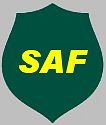
FOREST MANAGEMENT
GUIDELINES FOR MICHIGAN
By the Michigan Society of American Foresters
FOREST PROTECTION
Overall, Michigan's forests are healthy and productive. However, forests do experience periods of stress and decline. Stress is put on the forest by such things as fire, drought, storms, late spring frosts, diseases and insects, coupled with the advanced age of some forest types. These play a significant role in shaping Michigan's forests.
Declines, mortality and/or fire hazard are an integral part of the ecology of Michigan's even-aged forest types such as jack pine, spruce & fir, northern pin oak and aspen. Some other forest species, existing at the extreme north or south part of their natural range, find themselves stressed at times by extreme weather events. Recognizing, understanding and working with these and other limiting natural processes and events is an integral part of forest resource management.
Wildfire is a major concern in a forested landscape. Spring and fall are usually the periods of highest hazard due to the cured leaves, grass, and other vegetation that have accumulated from the previous growing season. Summer droughts can also be a time when serious wildfires may threaten the forest resource and interspersed homes. Diverse and increasing recreational use in the forest have increased the risk of wildfire. Things to consider that could reduce the hazard of wildfire are limiting access to the area, establishing fuel breaks, reducing fuel (like logging slash), and making users aware of fire danger.
 The
use of prescribed burning as a silvicultural treatment is a valuable tool in
the management and regeneration of several tree species, particularly jack and
red pine. Wildlife habitat may also be enhanced by the use of prescribed burning.
There are definite hazards to prescribed burning that require special planning
and preparation by experienced personnel.
The
use of prescribed burning as a silvicultural treatment is a valuable tool in
the management and regeneration of several tree species, particularly jack and
red pine. Wildlife habitat may also be enhanced by the use of prescribed burning.
There are definite hazards to prescribed burning that require special planning
and preparation by experienced personnel.
The increase of homes and housing developments in forest areas has added a new dimension to fire protection and the use of fire as a management tool. The people associated with this development bring with them the increased risk of wildfire ignitions. In addition, their structures now require additional suppression forces once a wildfire starts.

This website is maintained by Bill Cook, Michigan State University Extension
Forest in the Upper Peninsula. Comments, questions,
and suggestions are gratefully accepted.
Last update of this page was 8 May, 2008
This site is hosted by School of Forest Resources and Environmental Science at Michigan Technological University.